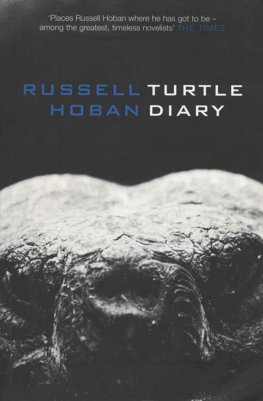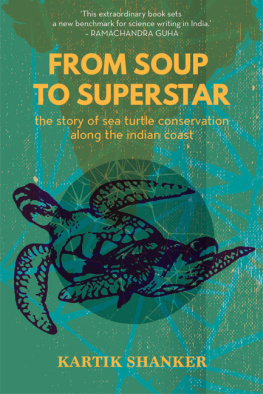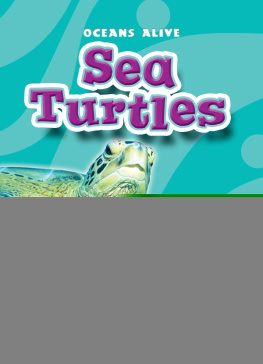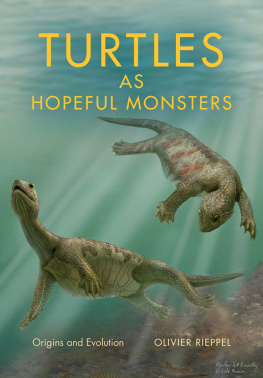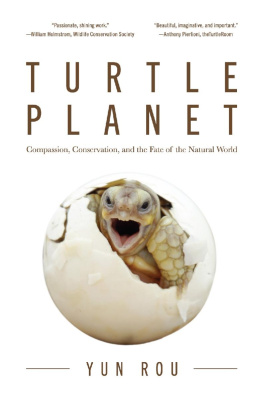SAVING SEA TURTLES
SAVING SEA TURTLES
Extraordinary Stories from the
Battle against Extinction

JAMES R. SPOTILA

2011 The Johns Hopkins University Press
All rights reserved. Published 2011
Printed in the United States of America on
acid-free paper
9 8 7 6 5 4 3 2 1
The Johns Hopkins University Press
2715 North Charles Street
Baltimore, Maryland 21218-4363
www.press.jhu.edu
Library of Congress Cataloging-in-Publication Data
Spotila, James R., 1944
Saving sea turtles : extraordinary stories from the battle
against extinction / James R. Spotila.
p. cm.
Includes index.
ISBN-13: 978-0-8018-9907-2 (hardcover : alk. paper)
ISBN-10: 0-8018-9907-9 (hardcover : alk. paper)
1. Sea turtles. I. Title.
QL666.C536S688 2011
639.9'77928dc22 2010023463
A catalog record for this book is available from the British Library.
Special discounts are available for bulk purchases of this book. For more information, please contact Special Sales at 410-516-6936 or specialsales@press.jhu.edu.
The Johns Hopkins University Press uses environmentally friendly book materials, including recycled text paper that is composed of at least 30 percent post-consumer waste, whenever possible. All of our book papers are acid-free, and our jackets and covers are printed on paper with recycled content.
To my wife, Laurie, without whose help I would not have accomplished anything in my professional life
and
to Frank Paladino, my student, colleague, and friend, who has been there with me and done the heavy lifting for many years
CONTENTS
PREFACE
There are only a few books that make a real difference in the world. The Windward Road: Adventures of a Naturalist on Remote Caribbean Shores by Archie Carr was certainly one of them. It led to a conservation movement on behalf of sea turtles that continues to this day. It inspired a generation of people to study and conserve sea turtles. I always thought that it would be interesting to write a book about the return to the windward road, about what the world of sea turtles is like today and what adventures await the reader on the Caribbean shore. However, I soon realized that you can never go home again. The world of the sea turtle will never be the same as it was in 1956, when Archie wrote that book. In addition, there is no way anyone will write a book as beautifully conceived and executed as the original.
Nevertheless, sea turtles need a voice in every generation. I have been fortunate to work with Archie and several of his students. I have also been fortunate to work with leaders of the conservation movement in Costa Rica like Mario Boza, lvaro Ugalde, Doa Karen Olsen, Mara Teresa Koberg, Randall Arauz, and others. I have been blessed to have some of the finest colleagues and students with whom any professor could ever wish to be associated. All of these people have worked to study and save sea turtles, and together we have learned some new and interesting things about sea turtles and have made some progress in saving them from extinction. I hope that this book can be a small voice for the turtles. It discusses their biology within the context of the struggle to save them. It contains facts and stories that will provide information and hope so that people today will begin the work of conservation anew and keep the dream alive of oceans full of sea turtles and beaches covered with hatchlings.
We all stand on the shoulders of those who have gone before us. There is no way that any one person can replace Archie Carr in all that he did and all that he stood for in the sea turtle world. However, if two or three of us work together we can make some progress, and if more people join in we can make a movement. That movement can turn the tide of slaughter in the oceans of the world and development on the nesting beaches. Then we can accomplish what Archie hoped for more than 50 years ago: bringing back the fleets of turtles that Columbus found when he discovered the New World.
The world is a much more complicated and crowded place today than it was in 1956. The problems are greater and more numerous, and we have less time left to solve them. We no longer have the luxury of eating sea turtles and their eggs, of making jewelry out of their shells and leather out of their skin. Old ways have to pass on if sea turtles are to move forward. There are too many people with too many needs and desires to keep up the pretense that sea turtles can be a source of sustainable harvest. Turtles live too long, they mature too old, and they reproduce too little to support use at the same rate per person that they did when the earth held many fewer people. But we still have time. If we work together, if we come together as a family on the nesting beaches, on the oceans, in the meeting rooms, and in the halls of politics, then we will be successful.
Those who come together to walk a turtle beach, to excavate a sea turtle nest to save some hatchlings, to work to stop fishing practices that kill turtles are part of a family. The very act of doing something for the turtles is an expression of faith in something larger than oneself. The reason that I have hope is that there is a large family of people who all do their part to save sea turtles for one more day. That work may be something small or something large. It may gain headlines or it may go unnoticed. It may involve a once-in-a-lifetime trip to a turtle beach or an everyday action. It may involve saving a pond turtle far from the sea or documenting bycatch on a fishing vessel in the middle of the ocean. I feel that I am a member of a great family of believers, believers in the future of sea turtles. You are my brothers and my sisters. Thank you for all that you are doing.
Thank you as well to all of my students and colleagues who have walked with me for the last 33 years of adventure and inquiry. You have inspired me to work harder to discover new knowledge about sea turtles, to educate people about sea turtles, and to work to save sea turtles. It is an honor to be part of your family.
Finally, thank you to all those who have helped make this book a reality. Mark Gatlin did a great job of editing the text on short notice, and Karen Bjorndal, Gabriela Blanco, Alan Bolten, Mario Boza, Laurie Cotroneo, Shaya Honarvar, Susan Kilham, Kenneth Lohmann, Rod Mast, Andrew McCollum, Anne Meylan, Sally Murphy, Carlos Mario Orrego, Frank Paladino, Pilar Santidrin Tomillo, Jeffrey Seminoff, George Shillinger, Annette Sieg, Paul Sotherland, and Edward Standora reviewed various chapters, and in some cases the entire manuscript, to check facts and information. An anonymous reviewer greatly improved the manuscript. Vincent Burke did an excellent job as the editor from concept to completion. I very much appreciate his insight, encouragement, and hard work. The content and opinions are mine, as are the sins of commission and omission.
SAVING SEA TURTLES
1
SEA TURTLES IN THE MODERN WORLD: WHERE DO WE STAND TODAY?
Everyone with a heart appreciates sea turtles. Some of us have bought stuffed green turtle toys for our children, others display sea turtle carvings made of stone or wood, and the most fortunate of us visit places like Hawaii, Cancn, and the Cayman Islands to watch sea turtles in the water. I have devoted the better part of my life to studying these impressive and, in their own way, beautiful animals. I invite you to come with me as I journey through my memories of the world of the sea turtle. We will visit them as helpless eggs and determined hatchlings, as adventurous juveniles and wise adults. We will look at how sea turtles lived in the past and the challenges that they face today.
Next page

